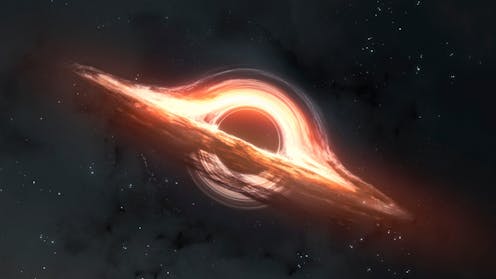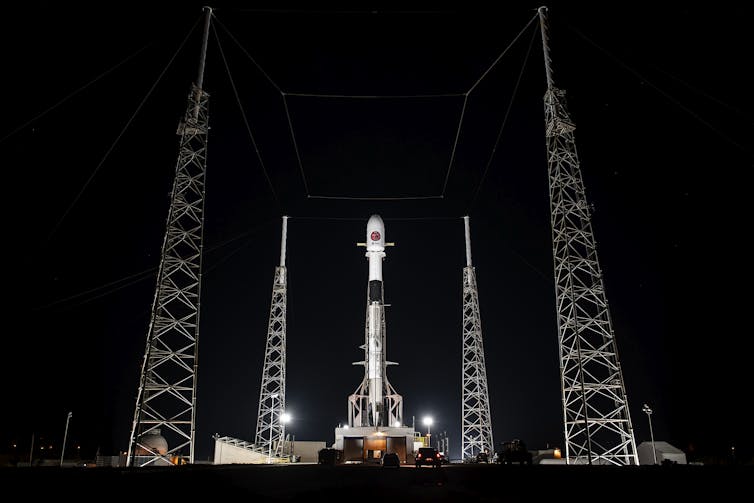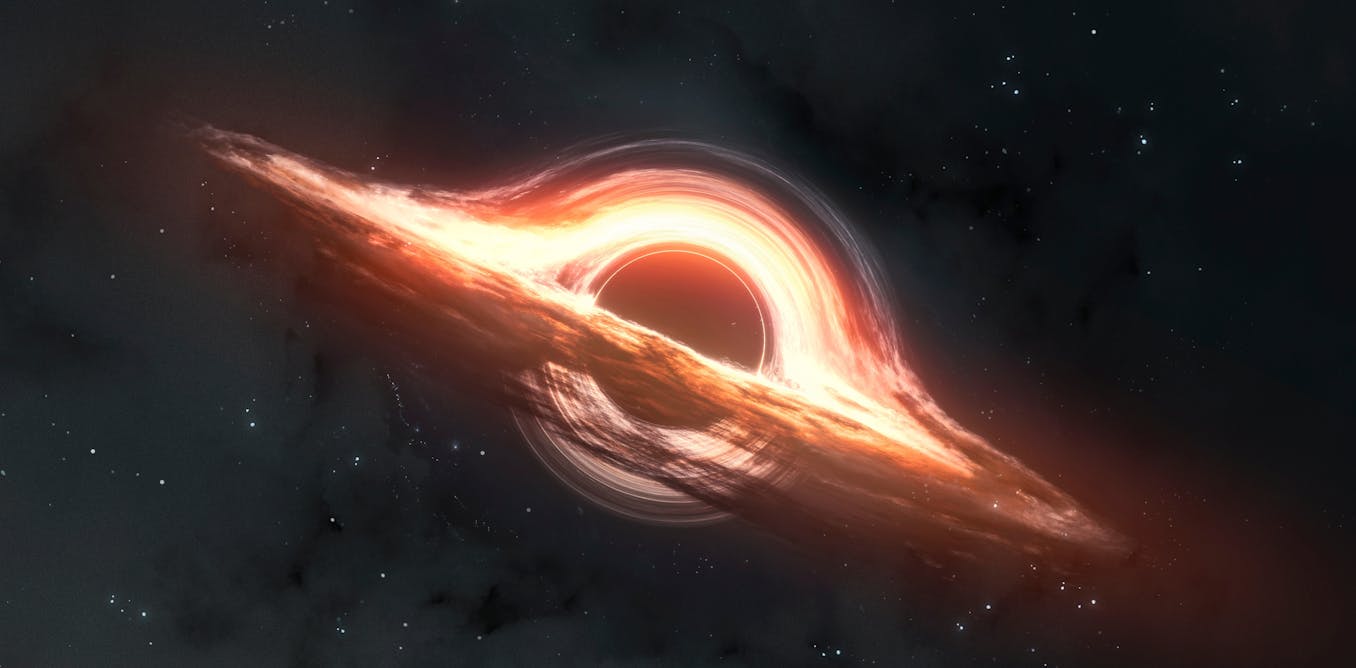[ad_1]

The Big Bang is often described as the explosive birth of the universe — a singular moment when space, time and matter sprang into existence. But what if this was not the beginning at all? What if our universe emerged from something else — something more familiar and radical at the same time?
In a new paper, published in Physical Review D, my colleagues and I propose a striking alternative. Our calculations suggest the Big Bang was not the start of everything, but rather the outcome of a gravitational crunch or collapse that formed a very massive black hole — followed by a bounce inside it.
This idea — which we call the black hole universe — offers a radically different view of cosmic origins, yet it is grounded entirely in known physics and observations.
Today’s standard cosmological model, based on the Big Bang and cosmic inflation (the idea that the early universe rapidly blew up in size), has been remarkably successful in explaining the structure and evolution of the universe. But it comes at a price: it leaves some of the most fundamental questions unanswered.
Get your news from actual experts, straight to your inbox. Sign up to our daily newsletter to receive all The Conversation UK’s latest coverage of news and research, from politics and business to the arts and sciences.
For one, the Big Bang model begins with a singularity — a point of infinite density where the laws of physics break down. This is not just a technical glitch; it’s a deep theoretical problem that suggests we don’t really understand the beginning at all.
To explain the universe’s large-scale structure, physicists introduced a brief phase of rapid expansion into the early universe called cosmic inflation, powered by an unknown field with strange properties. Later, to explain the accelerating expansion observed today, they added another “mysterious” component: dark energy.
In short, the standard model of cosmology works well — but only by introducing new ingredients we have never observed directly. Meanwhile, the most basic questions remain open: where did everything come from? Why did it begin this way? And why is the universe so flat, smooth, and large?
New model
Our new model tackles these questions from a different angle — by looking inward instead of outward. Instead of starting with an expanding universe and trying to trace back how it began, we consider what happens when an overly dense collection of matter collapses under gravity.
This is a familiar process: stars collapse into black holes, which are among the most well-understood objects in physics. But what happens inside a black hole, beyond the event horizon from which nothing can escape, remains a mystery.
In 1965, the British physicist Roger Penrose proved that under very general conditions, gravitational collapse must lead to a singularity. This result, extended by the late British physicist Stephen Hawking and others, underpins the idea that singularities — like the one at the Big Bang — are unavoidable.
The idea helped win Penrose a share of the 2020 Nobel prize in physics and inspired Hawking’s global bestseller A Brief History of Time: From the Big Bang to Black Holes. But there’s a caveat. These “singularity theorems” rely on “classical physics” which describes ordinary macroscopic objects. If we include the effects of quantum mechanics, which rules the tiny microcosmos of atoms and particles, as we must at extreme densities, the story may change.
In our new paper, we show that gravitational collapse does not have to end in a singularity. We find an exact analytical solution – a mathematical result with no approximations. Our maths show that as we approach the potential singularity, the size of the universe changes as a (hyperbolic) function of cosmic time.
This simple mathematical solution describes how a collapsing cloud of matter can reach a high-density state and then bounce, rebounding outward into a new expanding phase.
But how come Penrose’s theorems forbid out such outcomes? It’s all down to a rule called the quantum exclusion principle, which states that no two identical particles known as fermions can occupy the same quantum state (such as angular momentum, or “spin”).
And we show that this rule prevents the particles in the collapsing matter from being squeezed indefinitely. As a result, the collapse halts and reverses. The bounce is not only possible — it’s inevitable under the right conditions.
Crucially, this bounce occurs entirely within the framework of general relativity, which applies on large scales such as stars and galaxies, combined with the basic principles of quantum mechanics — no exotic fields, extra dimensions or speculative physics required.
What emerges on the other side of the bounce is a universe remarkably like our own. Even more surprisingly, the rebound naturally produces the two separate phases of accelerated expansion — inflation and dark energy — driven not by a hypothetical fields but by the physics of the bounce itself.
Testable predictions
One of the strengths of this model is that it makes testable predictions. It predicts a small but non-zero amount of positive spatial curvature — meaning the universe is not exactly flat, but slightly curved, like the surface of the Earth.
This is simply a relic of the initial small over-density that triggered the collapse. If future observations, such as the ongoing Euclid mission, confirm a small positive curvature, it would be a strong hint that our universe did indeed emerge from such a bounce. It also makes predictions about the current universe’s rate of expansion, something that has already been verified.

https://www.esa.int/Science_Exploration/Space_Science/Euclid, CC BY-SA
This model does more than fix technical problems with standard cosmology. It could also shed new light on other deep mysteries in our understanding of the early universe — such as the origin of supermassive black holes, the nature of dark matter, or the hierarchical formation and evolution of galaxies.
These questions will be explored by future space missions such as Arrakhis, which will study diffuse features such as stellar halos (a spherical structure of stars and globular clusters surrounding galaxies) and satellite galaxies (smaller galaxies that orbit larger ones) that are difficult to detect with traditional telescopes from Earth and will help us understand dark matter and galaxy evolution.
These phenomena might also be linked to relic compact objects — such as black holes — that formed during the collapsing phase and survived the bounce.
The black hole universe also offers a new perspective on our place in the cosmos. In this framework, our entire observable universe lies inside the interior of a black hole formed in some larger “parent” universe.
We are not special, no more than Earth was in the geocentric worldview that led Galileo (the astronomer who suggested the Earth revolves around the Sun in the 16th and 17th centuries) to be placed under house arrest.
We are not witnessing the birth of everything from nothing, but rather the continuation of a cosmic cycle — one shaped by gravity, quantum mechanics, and the deep interconnections between them.
![]()
Enrique Gaztanaga receives funding from the Spanish Plan Nacional (PGC2018-102021-B-100) and
Maria de Maeztu (CEX2020-001058-M) grants.
Enrique Gaztanaga is also a Professor at the Institute of Space Sciences (CSIC/IEEC) in Barcelona and publishes a science blog called Dark Cosmos.
[ad_2]
Source link



